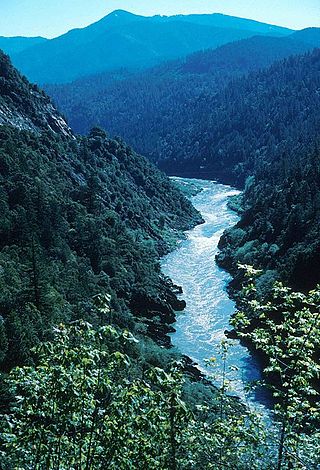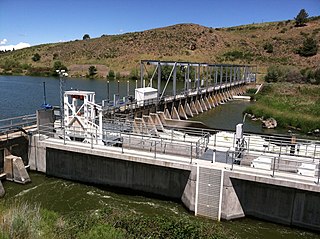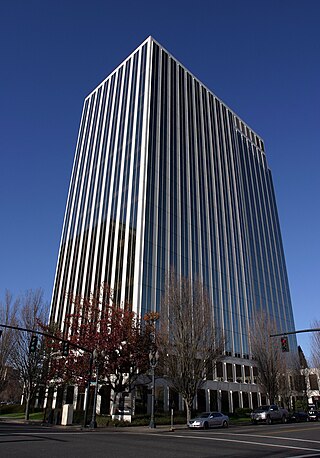
Wells Dam is a hydroelectric embankment dam located on the Columbia River, downstream from the confluence of the Okanogan River, Methow River, and the Columbia River in Washington state. The dam, associated structures, and machinery make up the Wells Hydroelectric Project. It is owned and operated by Douglas County Public Utility District.

The Klamath River is a 257-mile (414 km) long river in southern Oregon and northern California. Beginning near Klamath Falls in the Oregon high desert, it flows west through the Cascade Range and Klamath Mountains before reaching the temperate rainforest of California's North Coast, where it empties into the Pacific Ocean. The Klamath River is the third-largest salmon and steelhead producing river on the west coast of the contiguous United States. The river's watershed – the Klamath Basin – encompasses more than 15,000 square miles (39,000 km2), and is known for its biodiverse forests, large areas of designated wilderness, and freshwater marshes that provide key migratory bird habitat.

The Link River Dam is a concrete gravity dam on the Link River in the city of Klamath Falls, Oregon, United States. It was built in 1921 by the California Oregon Power Company (COPCO), the predecessor of PacifiCorp, which continues to operate the dam. The dam is owned by the U.S. Bureau of Reclamation.

The Klamath Project is a water-management project developed by the United States Bureau of Reclamation to supply farmers with irrigation water and farmland in the Klamath Basin. The project also supplies water to the Tule Lake National Wildlife Refuge, and the Lower Klamath National Wildlife Refuge. The project was one of the first to be developed by the Reclamation Service, which later became the Bureau of Reclamation.

PacifiCorp is an electric power company based in the Lloyd Center Tower in Portland, Oregon with operations in the western United States.

Condit Hydroelectric Project was a development on the White Salmon River in the U.S. state of Washington. It was completed in 1913 to provide electrical power for local industry, and is listed in the National Register of Historic Places as an engineering and architecture landmark.

The Klamath Basin is the region in the U.S. states of Oregon and California drained by the Klamath River. It contains most of Klamath County and parts of Lake and Jackson counties in Oregon, and parts of Del Norte, Humboldt, Modoc, Siskiyou, and Trinity counties in California. The 15,751-square-mile (40,790 km2) drainage basin is 35% in Oregon and 65% in California. In Oregon, the watershed typically lies east of the Cascade Range, while California contains most of the river's segment that passes through the mountains. In the Oregon-far northern California segment of the river, the watershed is semi-desert at lower elevations and dry alpine in the upper elevations. In the western part of the basin, in California, however, the climate is more of temperate rainforest, and the Trinity River watershed consists of a more typical alpine climate.

Glines Canyon Dam, also known as Upper Elwha Dam, was a 210-foot (64 m) tall concrete arch dam that impounded Lake Mills reservoir on the Elwha River in Clallam County, Washington. As of 2015, it is the tallest dam ever to be intentionally breached.

The John C. Boyle Dam was a hydroelectric dam located in southern Oregon, United States. It was on the upper Klamath River, south (downstream) of Keno, and about 12 miles (19 km) north of the California border. Originally developed and known as Big Bend, the John C. Boyle dam and powerhouse complex was re-dedicated to honor the pioneer hydroelectric engineer who was responsible for the design of virtually all of the Klamath Hydroelectric Project.
The Klamath River is a river in southern Oregon and northern California in the United States. This article describes its course.
The 2002 Klamath River fish kill occurred on the Klamath River in California in September 2002. According to the official estimate of mortality, about 34,000 fish died. Though some counts may estimate over 70,000 adult chinook salmon were killed when returning to the river to spawn, making it the largest salmon kill in the history of the Western United States. Besides the chinook salmon, other fish that perished include: steelhead, coho salmon, sculpins, speckled dace, and Klamath smallscale sucker.

Iron Gate Dam was an earthfill hydroelectric dam on the Klamath River in northern California, outside Hornbrook, California, that opened in 1964. The dam blocked the Klamath River to create the Iron Gate Lake Reservoir. It was the lowermost of a series of power dams on the river, the Klamath River Hydroelectric Project, operated by PacifiCorp. It also posed the first barrier to migrating salmon in the Klamath. The Iron Gate Fish Hatchery was placed just after the dam, hatching salmon and steelhead that were released back into the river.

Copco Lake was an artificial lake on the Klamath River in Siskiyou County, California, near the Oregon border. The lake's waters were impounded by the Copco Number 1 Dam, which was completed in 1922 as part of the Klamath River Hydroelectric Project.

John C. Boyle Reservoir was an artificial impoundment behind John C. Boyle Dam on the Klamath River in the U.S. state of Oregon. The lake was 16 miles (26 km) west-southwest of Klamath Falls along Oregon Route 66.

The Klamath Basin Restoration Agreement (KBRA) is an American multi-party legal agreement determining river usage and water rights involving the Klamath River and Klamath Basin in the states of California and Oregon. Discussion of the KBRA began in 2005. Parties to the agreement included the state of California, the state of Oregon, the Karuk Tribe, the Klamath Tribes, the Yurok Tribe, Del Norte County, California, Humboldt County, California, Klamath County, Oregon, Siskiyou County, California; 26 private individuals, companies, and local irrigation districts; and seven NGOs including California Trout and Trout Unlimited.
The Middle Fork Rogue River is a tributary of the South Fork Rogue River in the U.S. state of Oregon. It begins in Klamath County in the Sky Lakes Wilderness of the Cascade Range and flows generally northwest through the Rogue River – Siskiyou National Forest to meet the South Fork south of Prospect. The Middle Fork enters the South Fork about 4 miles (6 km) from the South Fork's confluence with the Rogue River.

Un-Dam the Klamath (#UnDamtheKlamath) is a social movement in the United States to remove the dams on the Klamath River primarily because they obstruct salmon, steelhead, and other species of fish from accessing the upper basin which provides hundreds of miles of spawning habitat. The dams have also significantly harmed Native American communities such as the Hupa, Karuk, Klamath, and Yurok. Four hydroelectric dams on the Klamath River in California and Oregon are being advocated for removal.

The North Umpqua Hydroelectric Project is a series of hydroelectric power generation facilities along the North Umpqua River in Douglas County, Oregon, United States. The project is owned and operated by PacifiCorp.
















